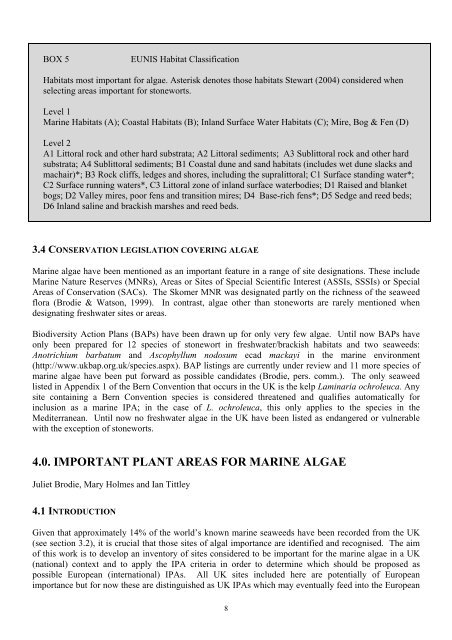Important Plant Areas for algae - Natural History Museum
Important Plant Areas for algae - Natural History Museum
Important Plant Areas for algae - Natural History Museum
Create successful ePaper yourself
Turn your PDF publications into a flip-book with our unique Google optimized e-Paper software.
BOX 5<br />
EUNIS Habitat Classification<br />
Habitats most important <strong>for</strong> <strong>algae</strong>. Asterisk denotes those habitats Stewart (2004) considered when<br />
selecting areas important <strong>for</strong> stoneworts.<br />
Level 1<br />
Marine Habitats (A); Coastal Habitats (B); Inland Surface Water Habitats (C); Mire, Bog & Fen (D)<br />
Level 2<br />
A1 Littoral rock and other hard substrata; A2 Littoral sediments; A3 Sublittoral rock and other hard<br />
substrata; A4 Sublittoral sediments; B1 Coastal dune and sand habitats (includes wet dune slacks and<br />
machair)*; B3 Rock cliffs, ledges and shores, including the supralittoral; C1 Surface standing water*;<br />
C2 Surface running waters*, C3 Littoral zone of inland surface waterbodies; D1 Raised and blanket<br />
bogs; D2 Valley mires, poor fens and transition mires; D4 Base-rich fens*; D5 Sedge and reed beds;<br />
D6 Inland saline and brackish marshes and reed beds.<br />
3.4 CONSERVATION LEGISLATION COVERING ALGAE<br />
Marine <strong>algae</strong> have been mentioned as an important feature in a range of site designations. These include<br />
Marine Nature Reserves (MNRs), <strong>Areas</strong> or Sites of Special Scientific Interest (ASSIs, SSSIs) or Special<br />
<strong>Areas</strong> of Conservation (SACs). The Skomer MNR was designated partly on the richness of the seaweed<br />
flora (Brodie & Watson, 1999). In contrast, <strong>algae</strong> other than stoneworts are rarely mentioned when<br />
designating freshwater sites or areas.<br />
Biodiversity Action Plans (BAPs) have been drawn up <strong>for</strong> only very few <strong>algae</strong>. Until now BAPs have<br />
only been prepared <strong>for</strong> 12 species of stonewort in freshwater/brackish habitats and two seaweeds:<br />
Anotrichium barbatum and Ascophyllum nodosum ecad mackayi in the marine environment<br />
(http://www.ukbap.org.uk/species.aspx). BAP listings are currently under review and 11 more species of<br />
marine <strong>algae</strong> have been put <strong>for</strong>ward as possible candidates (Brodie, pers. comm.). The only seaweed<br />
listed in Appendix 1 of the Bern Convention that occurs in the UK is the kelp Laminaria ochroleuca. Any<br />
site containing a Bern Convention species is considered threatened and qualifies automatically <strong>for</strong><br />
inclusion as a marine IPA; in the case of L. ochroleuca, this only applies to the species in the<br />
Mediterranean. Until now no freshwater <strong>algae</strong> in the UK have been listed as endangered or vulnerable<br />
with the exception of stoneworts.<br />
4.0. IMPORTANT PLANT AREAS FOR MARINE ALGAE<br />
Juliet Brodie, Mary Holmes and Ian Tittley<br />
4.1 INTRODUCTION<br />
Given that approximately 14% of the world’s known marine seaweeds have been recorded from the UK<br />
(see section 3.2), it is crucial that those sites of algal importance are identified and recognised. The aim<br />
of this work is to develop an inventory of sites considered to be important <strong>for</strong> the marine <strong>algae</strong> in a UK<br />
(national) context and to apply the IPA criteria in order to determine which should be proposed as<br />
possible European (international) IPAs. All UK sites included here are potentially of European<br />
importance but <strong>for</strong> now these are distinguished as UK IPAs which may eventually feed into the European<br />
8

















